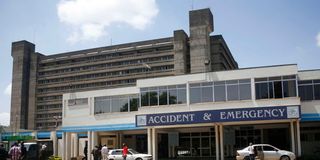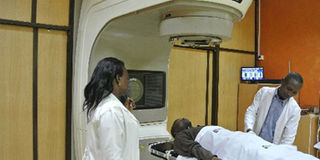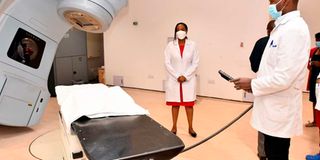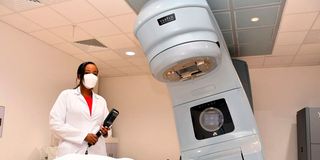
Kenyatta National Hospital.Twelve years after the government midwifed the birth of Universal Health Coverage, which was billed as a cornerstone of quality and affordable healthcare for all, Kenyans are still struggling with crippling costs and inadequate services.
Thousands of cancer patients are now trapped in a medical nightmare, clutching appointment cards they can no longer use as they wait for Kenyatta National Hospital to fix a crucial cancer treatment machine.
The hospital's linear accelerator machine (LINAC) has unexpectedly broken down, leaving desperate families staring at empty treatment chairs where hope once lived, now forced to confront their worst fears about survival.
The empty and quiet corridors of KNH's Cancer Treatment Centre tell a heartbreaking story. Patients who should be fighting cancer are instead fighting panic, asking the terrifying question: "When will I resume treatment?

Doctors prepare a patient for treatment using the Linear Accelerator (Linac) machine at Texas Cancer Centre. PHOTO | SARAH OOKO | NATION MEDIA GROUP
Waiting list woes
At the clinic, only chemotherapy services are being offered. An official at the Linac Clinic confirmed the hospital has only one LINAC machine and that they have been referring patients to other public facilities.
"The machines here are broken, and we have been turning away patients to access the services at the Kenyatta University Teaching, Referral and Research Hospital (KUTTRH) and to private facilities for the services," said an official, who spoke in confidence as he is not the official spokesperson.
For cancer patients, this isn't just an inconvenience, it's a race against death where every missed day hands their disease a deadly advantage. The patients have to either find money they don't have for private treatment or watch cancer claim ground in their bodies while waiting for a new machine to be procured.
In their bodies, every day without treatment gives the disease time to spread, hence making it more difficult after it spreads to the organs.
If the machines are not repaired on time so that they continue with their treatment, then the patients could be staring at death.
"Kenyatta National Hospital (KNH) wishes to inform the public that our Linear Accelerator (LINAC) Elekta machine, a vital piece of equipment in the treatment of cancer patients, has experienced an unexpected technical failure and is currently out of service," read a statement by the hospital released on May 28.

The hospital adds, "We recognise the critical importance of uninterrupted oncology services, and we immediately activated referral protocols to safeguard patient care. In the meantime, the procurement process for a replacement machine is being fast-tracked through the appropriate tendering procedures to restore full oncology services at the earliest possible time.
LINAC machine works like a special X-ray, targeting radiation to destroy cancer cells without hurting healthy tissue around them. The machine can shape radiation energy beams to exactly match the tumour's shape, even if oddly shaped, thus protecting healthy parts of the body.
For some small tumours, it can deliver very strong doses of radiation in just a few sessions, with incredible accuracy.
Outdated technology
A doctor who works for KNH, who did not want to be named for fear of victimisation, revealed that the machine is the only one in the entire hospital and that it has been broken since January this year.”
“It has not been working since January,” said the doctor. “Patients are being rendered out to private hospitals. He explained that the Cobalt radiotherapy machine, which KNH said “had previously broken down” and has now been fully restored and is operational, is outdated and results in more side effects compared to the Linac machine.
A source in KUTTRH said they had already started seeing an influx in cancer patients even before the machine at KNH broke down. He explains that they only have one Linac machine, which serves between 80 and 110 patients in a month.
“According to recommended standards, the machine should serve only 60 patients, but due to the high number of patients, we have to stretch the number. The waiting list has now stretched to as long as six months. A patient on radiotherapy would require between 21 and 36 sessions per day, each lasting between 15 and 20 minutes. And once they have started, it needs to be continuous until the required amount of treatment has been achieved,” he said.
“Radiotherapy patients have a list that the hospital uses to allocate them slots. We currently have patients who are on the waiting list from KNH. They need several sessions of radiotherapy since one needs several sessions once they begin treatment,” they said.
Patients from other counties have also been advised not to travel to Nairobi and to seek care in the Moi Teaching and Referral Hospital (MTRH).

Kenyatta University Teaching, Referral and Research Hospital (KUTRRH) Radiation Oncologist Dr Tracy Irura operating a Linac Accelerator machine at the hospital cancer ward on February 3, 2022. Picture by Francis Nderitu
LINAC breakdown
Phoebe Ongadi, the executive director of the Kenya Network of Cancer Organizations told Nation that cancer patients have been complaining that when they visit the hospital, the hospital asks them to leave their phone numbers and go home and wait.
“They are told the machine is broken and to go home and wait, but they do not tell them how long they should wait,” says Ms Ongadi.
“It’s long overdue for KNH, the only referral hospital in East and Central Africa, to have a consistent radiotherapy machine because the patience of patients with cancer is running out. Cancer is not a disease that has the benefit of time. We are not only demanding a stable radiotherapy machine, but we are also demanding a PET-CT scan. Most of the hospitals around have PET-CT scans, just not Kenyatta. Why not? They receive taxpayers' money!” said Ms Ongadi.
“That needs to be sorted once and for all. And then the LINAC machine, they keep telling us it's on the way, it's on the way. We want clear deadlines. How soon will it be here? Is it at the port? Is it at the scene? Where is it? They keep saying every year it is on the way, yet the patience of the patients is running out,” she added.
In Kenya, cancer is a significant public health concern, ranking as the third leading cause of death after infectious and cardiovascular diseases. According to the Kenya Medical Research Institute (KEMRI), cancer is the third leading cause of death in Kenya after infectious and cardiovascular diseases.
“According to GLOBOCAN estimates in 2022, the annual incidence of cancer was 44,726, and the number of prevalent cases (5 years) was 102,152. The five most common cancers in Kenya are breast, cervical, prostate, oesophagus and colorectal cancers. Women are disproportionately affected by cancer, with a higher incidence recorded in women as compared to men,” says Kemri.





